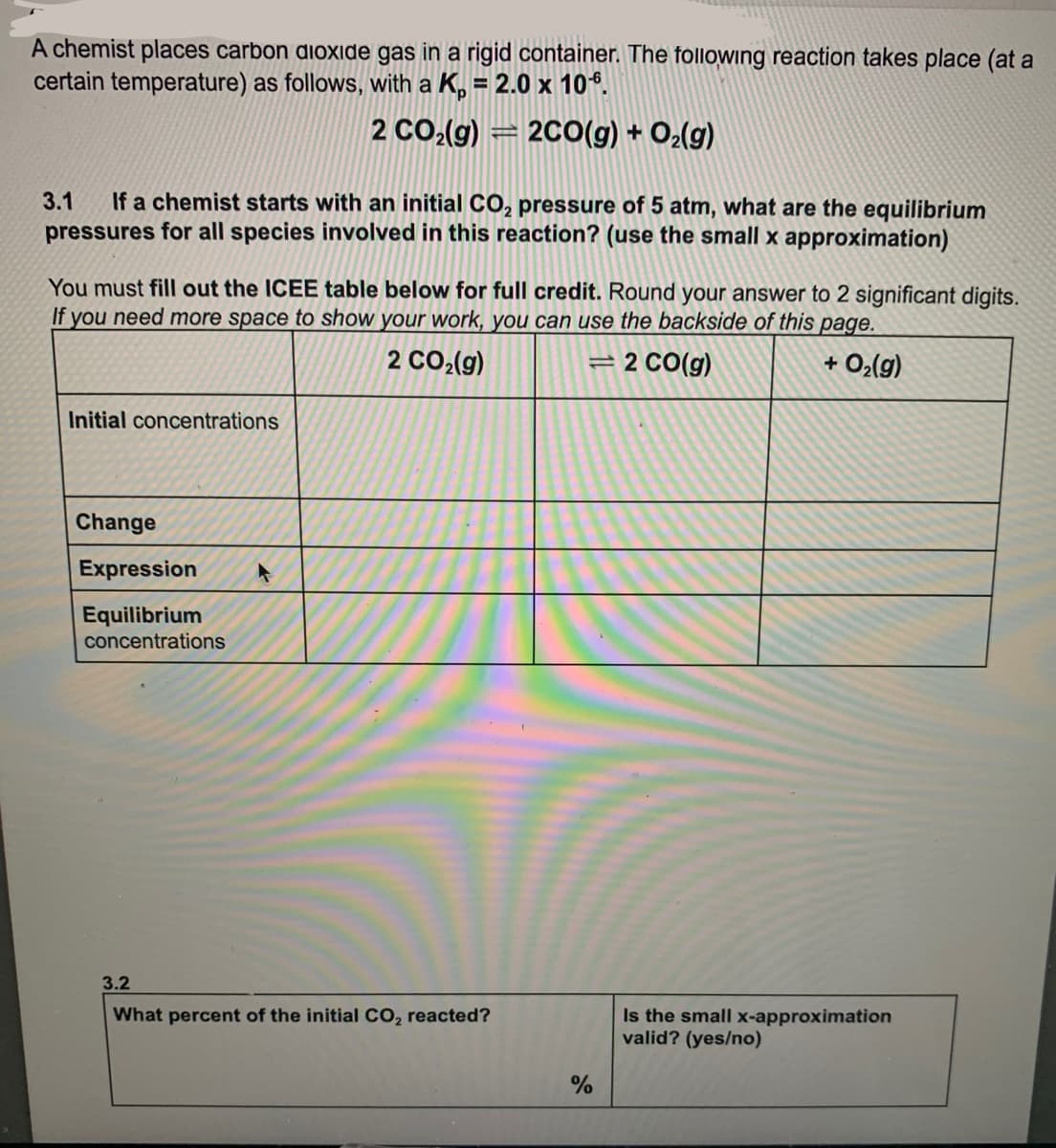A chemist places carbon dioxide gas in a rigid container. The following reaction takes place (at a certain temperature) as follows, with a K, = 2.0 x 10*. 2 CO,(g) = 200(g) + O2(g) If a chemist starts with an initial CO, pressure of 5 atm, what are the equilibrium pressures for all species involved in this reaction? (use the small x approximation) 3.1 You must fill out the ICEE table below for full credit. Round your answer to 2 significant digits. If you need more space to show your work, you can use the backside of this page. 2 Co,(g) 2 Co(g) + O2(g) %3D Initial concentrations Change Expression Equilibrium concentrations 3.2 Is the small x-approximation valid? (yes/no) What percent of the initial CO, reacted?
A chemist places carbon dioxide gas in a rigid container. The following reaction takes place (at a certain temperature) as follows, with a K, = 2.0 x 10*. 2 CO,(g) = 200(g) + O2(g) If a chemist starts with an initial CO, pressure of 5 atm, what are the equilibrium pressures for all species involved in this reaction? (use the small x approximation) 3.1 You must fill out the ICEE table below for full credit. Round your answer to 2 significant digits. If you need more space to show your work, you can use the backside of this page. 2 Co,(g) 2 Co(g) + O2(g) %3D Initial concentrations Change Expression Equilibrium concentrations 3.2 Is the small x-approximation valid? (yes/no) What percent of the initial CO, reacted?
Chemistry for Engineering Students
4th Edition
ISBN:9781337398909
Author:Lawrence S. Brown, Tom Holme
Publisher:Lawrence S. Brown, Tom Holme
Chapter12: Chemical Equilibrium
Section: Chapter Questions
Problem 12.103PAE: 12.103 Methanol, CH3OH, can be produced by the reaction of CO with H2, with the liberation of heat....
Related questions
Question

Transcribed Image Text:A chemist places carbon dioxide gas in a rigid container. The following reaction takes place (at a
certain temperature) as follows, with a K, = 2.0 x 10*.
2 CO.(g) = 200(g) + O¿(g)
If a chemist starts with an initial CO, pressure of 5 atm, what are the equilibrium
pressures for all species involved in this reaction? (use the small x approximation)
3.1
You must fill out the ICEE table below for full credit. Round your answer to 2 significant digits.
If you need more space to show your work, you can use the backside of this page.
2 CO,(g)
= 2 CO(g)
+ O2(g)
%3D
+
Initial concentrations
Change
Expression
Equilibrium
concentrations
3.2
What percent of the initial CO, reacted?
Is the small x-approximation
valid? (yes/no)
Expert Solution
This question has been solved!
Explore an expertly crafted, step-by-step solution for a thorough understanding of key concepts.
Step by step
Solved in 3 steps with 3 images

Knowledge Booster
Learn more about
Need a deep-dive on the concept behind this application? Look no further. Learn more about this topic, chemistry and related others by exploring similar questions and additional content below.Recommended textbooks for you

Chemistry for Engineering Students
Chemistry
ISBN:
9781337398909
Author:
Lawrence S. Brown, Tom Holme
Publisher:
Cengage Learning

Chemistry: The Molecular Science
Chemistry
ISBN:
9781285199047
Author:
John W. Moore, Conrad L. Stanitski
Publisher:
Cengage Learning

Chemistry: Principles and Reactions
Chemistry
ISBN:
9781305079373
Author:
William L. Masterton, Cecile N. Hurley
Publisher:
Cengage Learning

Chemistry for Engineering Students
Chemistry
ISBN:
9781337398909
Author:
Lawrence S. Brown, Tom Holme
Publisher:
Cengage Learning

Chemistry: The Molecular Science
Chemistry
ISBN:
9781285199047
Author:
John W. Moore, Conrad L. Stanitski
Publisher:
Cengage Learning

Chemistry: Principles and Reactions
Chemistry
ISBN:
9781305079373
Author:
William L. Masterton, Cecile N. Hurley
Publisher:
Cengage Learning

General Chemistry - Standalone book (MindTap Cour…
Chemistry
ISBN:
9781305580343
Author:
Steven D. Gammon, Ebbing, Darrell Ebbing, Steven D., Darrell; Gammon, Darrell Ebbing; Steven D. Gammon, Darrell D.; Gammon, Ebbing; Steven D. Gammon; Darrell
Publisher:
Cengage Learning

Introductory Chemistry: A Foundation
Chemistry
ISBN:
9781285199030
Author:
Steven S. Zumdahl, Donald J. DeCoste
Publisher:
Cengage Learning

Chemistry & Chemical Reactivity
Chemistry
ISBN:
9781133949640
Author:
John C. Kotz, Paul M. Treichel, John Townsend, David Treichel
Publisher:
Cengage Learning